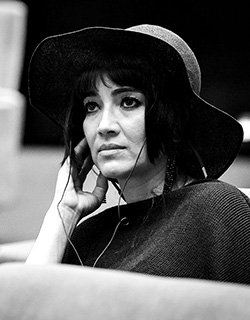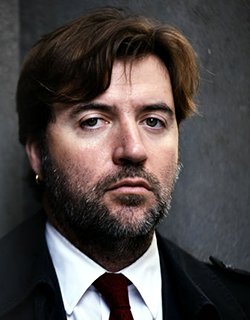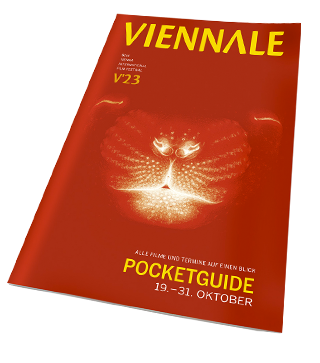In our VIENNALE DAILIES you'll find everything you need to know about what's happening around the festival!
QUOTE OF THE DAY
The intelligence of a room is larger than the number of people in it
(Lars Eidinger, on the importance of (open) cinemas)
NEED SOME FILMTIPS? HERE ARE SOME HIGHLIGHTS:

PACIFICTION
R: Albert Serra
SO, 23.10. 20:30 Uhr: GARTENBAUKINO
DI, 25.10. 21:00 Uhr: URANIA
A comedy set and shot in French Polynesia, its first image one of a paradise, half lost, half purgatory: a port full of ship containers at sunset. There, on the island of Tahiti, reigns the High Commissioner of the Republic and French government official De Roller, a man of culture and charisma, who is as devoted to the senses as he is to financial maneuvers. He maintains a delicate social equilibrium night and day with an economy of favors and arrangements. Suddenly, a group of sailors appears in the night with their captain, a man equal to De Roller but with the sea as his kingdom. Their presence breaks the fragile peace of the island, and a rumor starts of a threat that belongs to a recent, yet forgotten past: the sailors arrived in a submarine, and they have come to perform nuclear tests in the ocean. PACIFICTION revolves around the question of sovereignty. When a country is also a world power, do all its citizens count? The French overseas territories are at the center of this question, and the very existence of these as territories is at the heart of its comedy. If there is such a thing as hopeful cynicism, this is it. (Lucía Salas)


AFTERWATER
R: Dane Komljen
SO, 23.10. 17:30 Uhr: STADTKINO IM KÜNSTLERHAUS
MI, 26.10. 13:30 Uhr: METRO, HISTORISCHER SAAL
Three different main characters for three episodes shot in the different textures (three formats: digital, film and analog video), make up this delicate meditation on the mystery of the whole and the parts, and as well as upon the place of our species among other species, acknowledging without emphasis the singularity that defines it, language. Some of the characters are biologists, others perhaps members of religious orders, and the others do not display any attribute that determines them, except the fact of having a body and existing. Everyone enjoys the forests and mountains, feels the immense pleasure of diving and floating in the still waters of a lake. Everything that is seen and told can be experienced as if it were a kind of poetry constructed by geometric compositions in which the scale of each shot indicates a relationship between the one and the many, shots are combined with spoken and written texts, many from great writers, that nuance the beauty of the shots with symbolic suggestions kindly suggesting a path of interpretation. However, such a hermeneutical plus is not essential because the sensory pleasure of the aesthetic proposal is sufficient for an immersion into the physics of the world and its images. (Roger Koza)


NUCLEAR FAMILY
R: Travis Wilkerson, Erin Wilkerson
SO, 23.10. 18:45 Uhr: URANIA
MO, 24.10. 15:30 Uhr: STADTKINO IM KÜNSTLERHAUS
The road trip taken by the Wilkerson family is anything but tourism. Their chosen destinations delineate a cartography of annihilation: all the landscapes are linked to the 5,800 nuclear warheads currently scattered throughout the United States. Yet they also evoke the history of a country whose massacres ravaged the first settlers of the United States in the 19th Century, heralding a militaristic culture that was honed to perfection over a century, in particular in the year 1945. Travis Willkerson’s dramatic voiceover commands this tale, using fixed, geometric shots of different regions that contain nuclear weapon silos, nearly always beautiful geographies that have become the scene of explosions, genocides and suicides. To this cinematographic archaeology, the Wilkersons add a genealogy of nuclear warmongering in which the political conditions by which the first two nuclear bombs were perversely detonated are specified. Songs by SunRa, Radar Bros and Lorkin O’Reilly set archival material of past explosions to music, an indication of just how well the Wilkersons conceive sound and the importance it has in their poetics. The atmospheric information that arrives from the film’s sonic layers is a marvel and a demonstration of the distributive intelligence that governs the mise en scène. (Roger Koza)

SOLEIL Ô
R: Med Hondo
SO, 23.10. 13:00 Uhr: METRO, KINOKULTURHAUS
SOLEIL Ô is Med Hondo’s first feature and earned him the Golden Leopard at the Locarno Film Festival in 1970, instantly securing his place as one of the giants of African and world cinema. A loosely constructed narrative of the travails of an accountant confidently arriving in Paris to pursue his dreams, the film meticulously uncovers the challenges he faces, including racial, housing and employment discrimination along with sexual objectification. For Med Hondo, filming the migrant condition entails going beyond consequences and using caustic humor and imagination to analyze causalities (which include colonialism, the structures of capitalism and the implications of neocolonialism) in order to effect change.SOLEIL Ô remains as perceptive, timely and relevant in the 21st century as it was at the time of its release five decades ago. The film announces the arrival of a maverick director intent on challenging the very form of the medium. He makes a virtuoso use of digression and “unmotivated” non-diegetic inserts as part of his deployment and celebration of orature as an inexhaustible reservoir and resource for cinematic renewal and experimentation, “condensatory” and abstractive communicative symbolism, cinema verité and Eisensteinian montage, among other formal strategies.

LA BESTIA DEBE MORIR
R: Román Viñoly Barreto
SO, 23.10. 13:00 Uhr: FILMMUSEUM
This little known but extremely powerful version of Nicholas Blake’s novel was intended as a vehicle for Spanish actor Narciso Ibáñez Menta, who also co-wrote, co-produced and supervised the film. The original timeline of the plot was modified so that director Viñoly Barreto (who also made EL VAMPIRO NEGRO) could start the film with a violent family fight that escalates until one of its members drops dead. The victim turns out to be the “beast” of the title and from then on the film plays out as a mystery in flashback, with all the classic elements – love, hate, murder and revenge – appropriately displayed. In a very consistent cast, clearly chosen for the graphic value of their faces, Guillermo Battaglia stands out as the unredeemed villain of the piece.
SOME OF OUR GUESTS TODAY



Leandro Listorti
Director of
HERBARIA
Cyril Schäublin
Director of
UNRUEH
Nikolai Bosshardt
Actor in
UNRUEH
Chantal Scheiner
Production of
UNRUEH
Mitra Farahani
Director of
A VENDREDI, ROBINSON
Sharon Lockhart
Director of
EVENTIDE
Helena Wittmann
Director of
HUMAN FLOWERS OF FLESH
Angeliki Papoulia
Actress in
A LITTLE LOVE PACKAGE
HUMAN FLOWERS OF FLESH
David Wagner
Director of
EISMAYER
Dane Komljen
Director of
AFTERWATER
Zsuzsanna Kiràly
Production of
AFTERWATER
Albert Serra
Director of
PACIFICTION
Montse Triola
Production and Cast
PACIFICTION
Dmytro Sukholytkyy-Sobchuk
Director of
PAMFIR
WHAT IS HAPPENING IN THE VIENNALE CLUB TODAY?
Sunday, October 23 - from 7 pmr: LUMPLECKER (SCHOOL)
MATERIALS
Travis & Erin Wilkerson: NUCLEAR FAMILY
Helena Wittmann HUMAN FLOWERS OF FLESH
VIENNALE PODCAST
Politics and poetry in Iranian cinema: Ehsan Khoshbakht on Ebrahim Golestan

